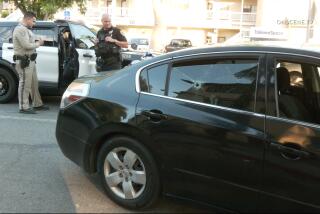Nightmare on Riverside Freeway : Traffic: With the growth of Riverside County beyond all expectations, officials are seeking solutions to the bumper-to-bumper commuter bottlenecks.
- Share via
CORONA — Almost 10 years ago, a new eight-lane stretch of the Riverside Freeway opened, bringing relief to Orange County residents making their way through Santa Ana Canyon into the Inland Empire.
Where drivers once had to maneuver along a narrow, winding highway, the freeway opening meant motorists could go from Anaheim Hills to Corona and on to Palm Springs and Las Vegas in record time.
But what was once hailed as a solution to gridlock has turned into one of the region’s worst nightmares. With the growth of Riverside County beyond anyone’s expectations, the corridor, within the past five years, has once again become a bottleneck. And this time, transportation officials in both counties doubt the problem has an easy solution.
Every weekday starting at 4 a.m., commuters heading to jobs in Orange County often travel bumper to bumper along the freeway, with traffic jams at times extending from Corona to the Costa Mesa Freeway.
These same commuters--many of whom moved to Riverside County seeking affordable housing--face the same gridlock coming home when eastbound traffic backs up for miles. In all, more than 200,000 vehicles pass through the corridor every day, and the volume is only getting worse.
“This is not the worst freeway in Southern California, but it’s getting there,” said Min-Der Day, a civil traffic engineer for the city of Corona.
While potential solutions, ranging from connector roads and parallel routes to commuter rails and double-decked freeways, are being proposed, all remain in the planning stages.
For now, Riverside and Orange county officials are pinning their hopes on the construction of car-pool lanes, one in each direction, that would stretch from Magnolia Avenue in Riverside to the Orange Freeway.
Riverside County will fund most of its portion of the project with money generated from a countywide half-cent sales tax passed last year. Construction is expected to begin in January.
But Orange County still has no funding, and transportation experts warn that if lanes are built only in Riverside County, the situation won’t be much better because traffic will simply become snarled at the county line.
Stanley T. Oftelie, executive director of the Orange County Transportation Commission, suggested that Riverside County lend Orange County money so the new lanes could be built at the same time.
But Jack Reagan, the executive director of the Riverside County Transportation Commission, said he doubts the board would approve such a request.
“There’s no way we could spend our highway money for a project in another county,” Reagan said.
And even with the car-pool lanes, officials worry that it is too little, too late.
“It’s a start, but it’s not going to meet the demand for the next 20 years,” Day said. “It doesn’t matter how big the roadway is, it’s not enough. One accident is going to stop all the traffic.”
Jim Bradley, the executive vice president of the Corona Chamber of Commerce, predicted that within two or three years after the lanes open, traffic will once again come to a halt because of the heavy growth in the area.
Corona officials say the solution rests in diverting traffic away from Corona. They are anxious to do something about the heavy traffic on local streets caused by thousands of commuters who cut through Corona to avoid the Riverside Freeway.
“People make a parking lot out of our city,” Bradley said.
Corona officials are among the most vocal advocates of an alternative, parallel route to the Riverside Freeway that would go through the Cleveland National Forest. The route, called the Cajalco corridor, would link on the east with the existing two-lane Cajalco Road between the Corona Freeway and the Escondido Expressway, and on the west with the proposed Foothill or Eastern toll road in Orange County.
The Riverside County Transportation Commission has commissioned a $285,000 study of the corridor, Reagan said. The cost of the project, if it ever is built, could exceed $500 million, he said.
But Orange County officials say that any such road is bound to run into environmental opposition.
“It illustrates the desperation Riverside folks are feeling to find an alternate route,” Oftelie said. He added that OCTC has been unable to widen the Ortega Highway, an existing route through the same forest, because of environmental concerns.
Meanwhile, Orange County officials are studying the idea of a commuter train that would link the two counties along existing track that runs parallel to the freeway, said Kia Mortazavi, the manager of highway programs with OCTC. The project could be partially funded with revenue generated from the state gas-tax initiative, he said.
But what could ultimately alter the traffic flow is a gradual shift in jobs to Riverside County.
“(Employees) can’t work well when they’re blown away in their fatigue,” Reagan said. “It’s going to happen. We just want it to happen quicker.”
Proposed Riverside Freeway Solutions 1. Addition of a car-pool lane in each direction from the Orange Freeway to Magnolia Avenue in Riverside. 2. Commuter train on existing Santa Fe rail track. 3. /4. Corona expressway connector road through Tonner and Soquel canyons. 5. Cajaico Expressway through Cleveland National Forest. 6. Proposed Foothill toll road.
More to Read
Sign up for Essential California
The most important California stories and recommendations in your inbox every morning.
You may occasionally receive promotional content from the Los Angeles Times.










